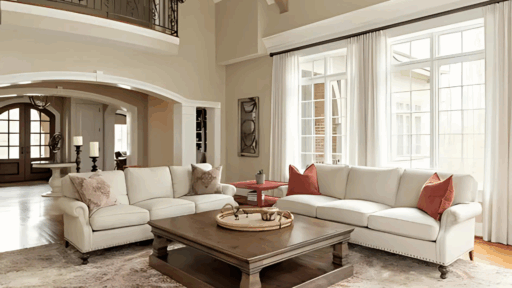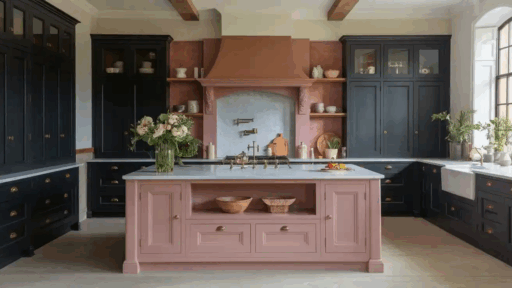White Dove (OC-17) by Benjamin Moore, with an LRV of 83.16,is a soft, warm white that works well in various spaces, including walls, trim, cabinets, and even exteriors.
It’s popular because it doesn’t feel too bright or too yellow, making it a safe pick for many home styles. But sometimes, using White Dove isn’t possible.
You might be working with a painter who only uses Sherwin-Williams, or there may not be a Benjamin Moore store nearby.
Some people also seek alternative options due to cost or convenience. That’s why I made this guide – to help you find the closest Sherwin-Williams match.
I’ll show you the top option, compare it to similar alternatives, and share what you need to know before making a decision.
What Is Benjamin Moore’s White Dove?
White Dove is a soft white with a warm touch and a light gray base. Some people call it an “off-white,” but it doesn’t look dull or plain. Instead, it creates a calm and welcoming atmosphere in any room.
It works well in many areas of the home. People often use it in living rooms, bedrooms, and hallways. It’s also a popular choice for trim, cabinets, and ceilings because it fits so many styles.
What makes White Dove so popular is its even and smooth appearance. It’s neither too bright nor too cold, and it doesn’t lean towards yellow or beige.
It provides a warm, clean look that complements wood, stone, and even more fabulous gray shades. It’s a solid pick for both new and classic homes.
Why Look for a Sherwin-Williams Equivalent to White Dove?
Finding a Sherwin-Williams match for White Dove makes sense for several reasons. Not every painter uses Benjamin Moore.
In some areas, Sherwin-Williams stores are more easily accessible. If other rooms in the house are already painted with Sherwin-Williams colors, it’s often easier to stick with the same brand.
A close match also helps with touch-ups or future updates. Using just one brand can save time and make the whole process smoother. It keeps the look of your space even and well-matched.
The Closest Sherwin-Williams Match to White Dove

The best Sherwin-Williams match for White Dove is Alabaster (SW 7008). If you’re looking for a paint that gives a similar look and feel, Alabaster is a strong choice.
- It has a very similar warmth and softness.
- Like White Dove, it’s a creamy white that doesn’t feel too bright or too yellow.
- It works well on trim, walls, and even the outside of a home.
- It’s one of Sherwin-Williams’ most used whites, for good reason.
Side-by-Side Comparison
When choosing between White Dove and Alabaster, it’s helpful to compare their features. Both are soft, warm whites that work well in many parts of the home.
But they’re not the same. This chart breaks down the key details – such as undertones, brightness, and where each one works best – so you can decide which one best fits your space.
| Feature | White Dove (OC-17) | Alabaster (SW 7008) |
|---|---|---|
| Brand | Benjamin Moore | Sherwin-Williams |
| Undertones | Warm with a hint of gray | Warm with a slight beige |
| LRV | 85.38 | 82 |
| Finish Options | All types available | All types available |
| Best Uses | Walls, trim, cabinets | Same |
Sherwin-Williams Options to Consider
If Alabaster isn’t quite what you’re looking for, there are a few other Sherwin-Williams whites that come close to White Dove.
Each one has a slightly different undertone or brightness, so the best fit depends on your space and lighting. Below is a brief overview of three viable alternatives and their comparative features.
| Color Name | Undertone | How It Compares to White Dove | Best Use |
|---|---|---|---|
| Greek Villa (SW 7551) | Warm, creamy | Warmer than White Dove; looks soft in low light | Cozy rooms, traditional spaces |
| Snowbound (SW 7004) | Cool, crisp white | Brighter and cooler, not an exact match, but it feels modern | Modern rooms, bright spaces |
| Egret White (SW 7570) | Greige, muted warmth | Closer if you like White Dove’s soft gray side | Neutral rooms, transitional styles |
Testing White Dove (or Its Match) First
color like White Dove might look soft and warm in one space, but cooler in another. That’s why it’s smart to test paint before making a final choice.
Why Samples Matter
- Paint colors can look very different from room to room
- Lighting (natural or artificial) affects how warm or cool a color feels
- White Dove may shift in tone depending on nearby colors and surfaces
Tips for Testing
- Use peel-and-stick samples or paint small swatches on your wall
- Test in multiple rooms if possible
- Check the color in morning, afternoon, and evening light
- Compare samples next to your trim, flooring, and furniture
- Don’t rush – seeing the color in context helps avoid regret later
White Dove vs. Alabaster in Real Homes
White Dove and Alabaster are both soft, warm whites that work in many parts of the home. But when you look closely, you’ll notice slight differences in how they behave on different surfaces.
On Walls

Both White Dove and Alabaster create soft walls that evoke a sense of calm and welcome. White Dove has a slight gray tone that adds a steady, smooth look, especially in daylight.
It works well in modern and mixed-style spaces. Alabaster feels slightly warmer and works well in rooms with golden sunlight or warm bulbs.
On Trim

The white dove provides a soft contrast against cool walls without being too sharp. Alabaster adds a warmer touch and blends well with beige or soft off-whites.
Both look clean when used in satin or semi-gloss. They hold up well on doors, windows, and moldings, giving a neat finish without drawing too much attention.
On Exteriors

Both colors work well outside. They reflect sunlight without looking too bright. A White Dove can appear a bit cooler in whole light, especially when paired with green plants or gray stone.
Alabaster stays warm and soft, with less shine in intense sun. They both stay true across seasons. The best one depends on the other colors in your home and how warm or cool you want it to be.
What Designers Say About White Dove vs. Alabaster
Both White Dove and Alabaster are designer favorites – but how they’re used depends on the space and style of the home.
- White Dove is commonly used in homes with cooler tones, minimal decor, or a transitional style.
- Alabaster shows up more in farmhouse or traditional homes, where warmth is ke.
- Designers like Alabaster for open floor plans because it adds a soft, cozy feel across large spaces.
- The White Dove is often chosen for modern coastal or classic interiors where balance and brightness are essential.
Which Should You Pick: White Dove or Alabaster
White Dove and Alabaster are very close, but the right one for your project depends on a few simple factors.
Think about your light, what other colors you’re using, and whether you’re trying to match something that’s already in place
Go with Alabaster if:
- You’re already using Sherwin-Williams paint.
- You prefer a slightly You’ve, creamier white.
- You’ve used Alabaster in other parts of the home and want consistency.
Stick to White Dove if:
- You want a soft white with a calm, balanced tone.
- You’re trying to match paint from a room that already uses White Dove.
- You prefer a white that leans a little more neutral than creamy.
Conclusion
White Dove and Alabaster are both solid picks if you want a warm white. They aren’t exact matches, but the difference won’t be slight – most people won’t spot it unless the two are side by side.
White Dove leans a bit more neutral with a light gray base, while Alabaster has a warmer, cream-like feel. Both look good in most rooms, whether on walls, trim, or outside.
That said, small changes in tone can make a big difference. That’s a little room. That’s why it’s smart to test before you paint.
A color that looks good on a sample card may appear differently in your space. I suggest using a small test pot or a peel-and-stick sample. Check it at different times of day.
See how it looks with your floors, furniture, and lighting. This simple step can help you feel sure before moving forward – and save time, money, and effort.








